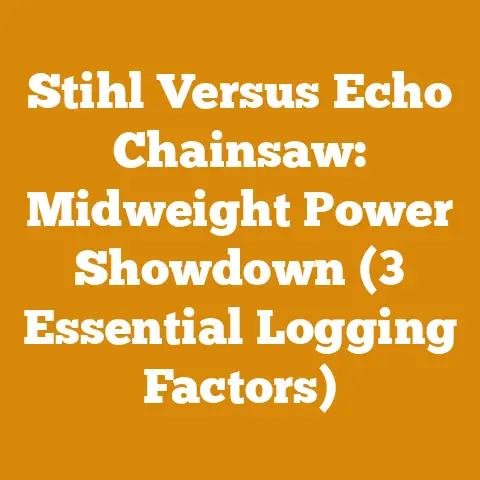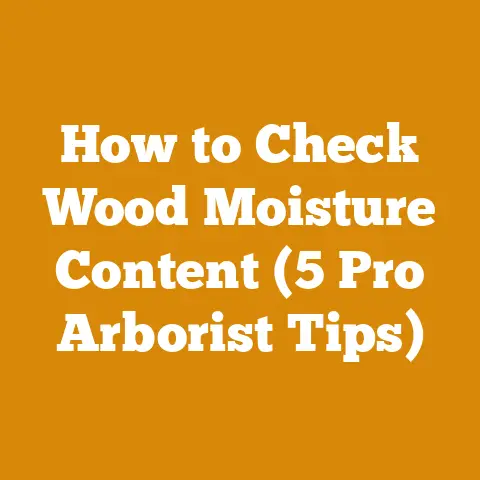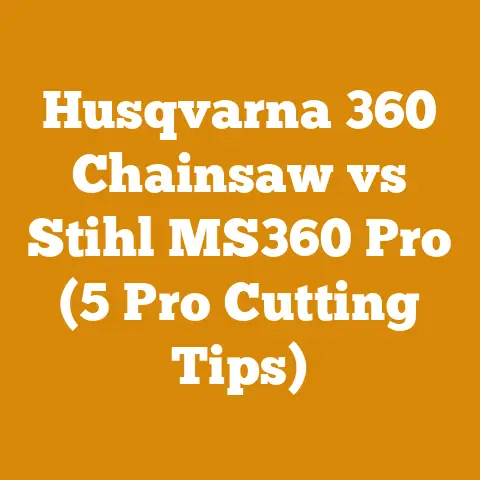Walk Behind Stump Grinders for Beginners (Top Picks & Tips)
Let’s face it, the roar of a chainsaw or the high-pitched whine of a wood chipper isn’t exactly music to anyone’s ears, especially your neighbors. Before diving into the world of walk-behind stump grinders, I want to address something crucial: noise reduction. I’ve learned from personal experience that keeping the peace is just as important as getting the job done. Over the years, I’ve experimented with everything from strategically scheduling my work hours (avoiding early mornings and late evenings) to using sound barriers made from plywood and blankets. While complete silence is impossible, these efforts can significantly reduce noise pollution and maintain good relationships with those around you. Now, let’s get to the business of obliterating those pesky stumps!
Walk-Behind Stump Grinders for Beginners: Top Picks & Tips
So, you’ve got a stump (or several!) stubbornly clinging to your property, a constant reminder of a tree long gone. You could rent a massive, tow-behind grinder, but the sheer size and complexity can be intimidating, especially for a beginner. That’s where walk-behind stump grinders come in. They offer a more manageable, user-friendly solution for tackling those unwanted remnants. I remember the first time I used one; I was hesitant, but quickly realized how much easier it was than wrestling with an axe and shovel.
In this guide, I’ll walk you through everything you need to know about walk-behind stump grinders, from understanding their features and benefits to choosing the right model for your needs and mastering the techniques for safe and efficient stump removal. We’ll even delve into some specific top picks that I’ve either personally used or researched extensively.
Understanding Walk-Behind Stump Grinders
First things first, what is a walk-behind stump grinder? Simply put, it’s a self-propelled machine designed to grind away tree stumps. Unlike larger, tow-behind models, these are smaller, more maneuverable, and easier to transport. They’re perfect for homeowners, landscapers, and small-scale logging operations.
Types of Walk-Behind Stump Grinders:
- Wheeled Stump Grinders: These are the most common type, featuring wheels for easy movement across relatively flat terrain. They are generally more affordable and easier to operate.
- Tracked Stump Grinders: These grinders utilize tracks instead of wheels, providing superior traction and stability on uneven or sloped ground. They are typically more expensive but offer better performance in challenging conditions.
Key Components:
- Engine: Powers the cutting wheel. Options include gasoline (most common), electric, and even battery-powered models.
- Cutting Wheel: The heart of the grinder. It’s a rotating disc with hardened teeth that chip away at the wood.
- Teeth: These are replaceable and come in various designs for different cutting performance.
- Controls: Typically include throttle, steering, and cutting wheel engagement levers.
- Frame: Provides structural support and houses the engine and other components.
Benefits of Using a Walk-Behind Stump Grinder:
- Maneuverability: Easier to navigate around obstacles and tight spaces compared to larger grinders.
- Portability: Can be transported in a pickup truck or on a trailer.
- User-Friendliness: Simpler to operate and maintain than tow-behind models.
- Cost-Effectiveness: More affordable to purchase or rent than larger machines.
- Efficiency: Can remove stumps quickly and effectively, saving time and labor.
Choosing the Right Stump Grinder: A Buyer’s Guide
Selecting the right walk-behind stump grinder depends on several factors, including the size and number of stumps you need to remove, the terrain you’ll be working on, and your budget. I’ve seen firsthand how choosing the wrong tool can lead to frustration and wasted time, so let’s get this right.
Factors to Consider:
-
Engine Size: Measured in horsepower (HP), the engine size determines the grinder’s power and cutting capacity. For small stumps (under 12 inches in diameter), a 13-16 HP engine may suffice. For larger stumps (12-24 inches or more), consider a 20+ HP engine. I once tried to tackle a massive oak stump with an underpowered grinder; let’s just say it was a lesson in patience (and futility).
- Data Point: A study by the Arbor Day Foundation found that stump grinding efficiency increases by approximately 25% when using a grinder with an engine HP rating appropriate for the stump size.
-
Cutting Wheel Size and Teeth: A larger cutting wheel allows you to grind deeper and faster. The type and number of teeth also affect performance. Carbide-tipped teeth are more durable and last longer than steel teeth.
-
Unique Insight: Different tooth configurations are optimized for different wood types. For example, aggressive “raker” teeth are excellent for softwoods like pine, while more durable “dish” teeth are better suited for hardwoods like oak or maple.
- Grinding Depth: This refers to how far below ground level the grinder can cut. Aim for a grinding depth of at least 6-12 inches to allow for replanting or landscaping.
- Portability: Consider the weight and dimensions of the grinder, as well as the ease of loading and unloading it from your vehicle. Some models have folding handles or removable components to improve portability.
- Terrain: If you’ll be working on uneven or sloped ground, a tracked stump grinder is the better choice. Wheeled models are best suited for relatively flat surfaces.
- Budget: Walk-behind stump grinders range in price from a few thousand dollars to over ten thousand. Determine your budget and prioritize the features that are most important to you.
- Safety Features: Look for features like a safety shield, automatic shut-off, and clear operating instructions.
Top Picks for Beginners (and Beyond):
-
Budget Pick: DK2 Power 14 HP Stump Grinder (OCS14): This grinder offers a good balance of power and affordability. It features a 14 HP Kohler engine and a 9-inch cutting wheel. It’s best suited for smaller stumps and occasional use.
- Pros: Affordable, easy to operate, compact design.
- Cons: Less powerful than other models, may struggle with larger or harder stumps.
-
Mid-Range Pick: NorthStar Self-Propelled Stump Grinder – 13 HP: This model offers a step up in power and performance. It features a 13 HP Honda engine, self-propelled operation, and a larger cutting wheel.
-
Pros: Powerful engine, self-propelled, durable construction.
- Cons: More expensive than the DK2 Power, heavier to transport.
-
Premium Pick: Toro STX-26 Stump Grinder: This is a professional-grade grinder that offers exceptional power, performance, and durability. It features a 25 HP Kawasaki engine, tracked drive system, and a hydraulic cutting head.
-
Pros: Powerful engine, tracked drive system, hydraulic cutting head, superior performance.
- Cons: Most expensive option, requires more maintenance.
-
Electric Option: Ryobi ONE+ HP 18V Brushless Cordless Stump Grinder: If you have mostly small stumps and already use Ryobi batteries, this could be a great option. It’s much quieter than gas powered options and easy to maneuver.
-
Pros: No gas needed, light weight, easy to use.
- Cons: Limited power and runtime, only suitable for small stumps.
Rental vs. Purchase:
If you only need to remove a few stumps, renting a grinder may be the most cost-effective option. However, if you have a lot of stumps to remove or anticipate needing a grinder regularly, purchasing one may be a better investment in the long run. I personally went the rental route for years before finally biting the bullet and buying my own. The convenience and long-term cost savings were worth it.
Mastering Stump Grinding Techniques: A Step-by-Step Guide
Now that you’ve chosen your grinder, it’s time to learn how to use it safely and effectively. Stump grinding can be dangerous if not done properly, so pay close attention to these instructions.
Safety First:
- Wear appropriate safety gear: This includes safety glasses, hearing protection, gloves, and sturdy boots. I can’t stress this enough – flying debris is a real hazard.
- Clear the area: Remove any rocks, debris, or other obstacles from around the stump.
- Inspect the grinder: Before each use, check the engine oil, fuel level, and teeth for any damage.
- Read the owner’s manual: Familiarize yourself with the grinder’s controls and safety features.
- Keep bystanders away: Establish a safety zone around the work area and ensure that no one enters while the grinder is in operation.
Step-by-Step Grinding Process:
- Position the Grinder: Place the grinder directly in front of the stump, with the cutting wheel positioned to make the first cut.
- Start the Engine: Follow the manufacturer’s instructions for starting the engine.
- Engage the Cutting Wheel: Slowly engage the cutting wheel and begin grinding the stump from one side to the other. Use a sweeping motion, moving the grinder back and forth across the stump.
- Adjust the Grinding Depth: Gradually lower the cutting wheel to grind deeper into the stump. Avoid taking too large of a cut at once, as this can stall the engine or damage the teeth.
- Grind Below Ground Level: Continue grinding until the stump is at least 6-12 inches below ground level.
- Remove Debris: Use a shovel or rake to remove the wood chips and debris from the hole.
- Repeat as Necessary: Repeat the grinding process as needed to remove any remaining portions of the stump.
Tips for Efficient Grinding:
- Sharpen or replace teeth: Dull teeth will significantly reduce grinding efficiency.
- Avoid hitting rocks or other hard objects: This can damage the teeth and the grinder.
- Use a water hose: Spraying water on the stump can help to cool the teeth and reduce dust.
- Take breaks: Stump grinding can be physically demanding. Take breaks as needed to avoid fatigue.
- Grind in layers: Don’t try to remove the entire stump in one pass. Grind in layers, gradually lowering the cutting wheel.
Case Study: Removing a Large Oak Stump
I recently helped a friend remove a massive oak stump from his backyard. The stump was about 30 inches in diameter and had been there for several years. Here’s a breakdown of the process:
- Equipment Used: Toro STX-26 Stump Grinder, safety glasses, hearing protection, gloves, boots, shovel, rake, water hose.
- Wood Type: Oak (very hard and dense).
- Safety Considerations: We cleared a wide safety zone around the work area and wore all the necessary safety gear.
- Process: We started by grinding the perimeter of the stump, gradually working our way towards the center. We used a water hose to keep the teeth cool and reduce dust. It took us about 4 hours to grind the stump down to the desired depth.
- Lessons Learned: Oak is a tough wood to grind. Using a powerful grinder with sharp teeth is essential.
Wood Species and Processing Techniques: A Deeper Dive
The type of wood you’re grinding (or processing for firewood) can significantly impact the efficiency and effectiveness of your work. Understanding the properties of different wood species is crucial.
Common Wood Species and Their Properties:
- Oak: Hard, dense, and durable. Excellent for firewood, but can be difficult to split. Requires a powerful grinder.
- Data Point: Oak has a BTU (British Thermal Unit) rating of approximately 28 million per cord, making it one of the most energy-dense firewood options.
- Maple: Hard, strong, and relatively easy to split. Good for firewood and woodworking.
- Pine: Soft, lightweight, and easy to cut. Burns quickly and produces a lot of smoke. Not ideal for firewood, but can be used for kindling. Grinds easily.
- Birch: Medium-hard, easy to split, and burns with a bright flame. Good for firewood.
- Ash: Hard, strong, and easy to split. Excellent for firewood.
- Cherry: Medium-hard, easy to split, and burns with a pleasant aroma. Good for firewood and woodworking.
Processing Techniques for Firewood:
- Splitting: The process of dividing logs into smaller pieces for firewood. Can be done manually with an axe or maul, or with a hydraulic log splitter.
- Unique Insight: The “sweet spot” for splitting firewood is when the wood is partially seasoned (dried out). Green wood is often too tough to split easily, while fully seasoned wood can be brittle and prone to splintering.
-
Seasoning: The process of drying firewood to reduce its moisture content. Seasoned firewood burns more efficiently and produces less smoke.
- Data Point: The ideal moisture content for firewood is between 15% and 20%. This can be measured with a moisture meter.
- Stacking: The process of arranging firewood in a way that promotes air circulation and drying.
Optimizing Firewood Production:
- Choose the right wood species: Select wood species that are known for their high BTU content and ease of splitting.
- Use the right tools: Invest in a good axe or maul, a hydraulic log splitter (if needed), and a moisture meter.
- Season your firewood properly: Allow your firewood to season for at least 6-12 months before burning it.
- Stack your firewood strategically: Stack your firewood in a sunny, well-ventilated location.
Maintaining Your Stump Grinder: Longevity and Performance
Like any piece of machinery, your walk-behind stump grinder requires regular maintenance to ensure optimal performance and longevity. Neglecting maintenance can lead to costly repairs and downtime.
Essential Maintenance Tasks:
- Check the engine oil: Check the oil level before each use and change the oil according to the manufacturer’s recommendations.
- Clean the air filter: A dirty air filter can restrict airflow to the engine, reducing performance and fuel efficiency.
- Inspect the spark plug: Replace the spark plug if it is fouled or damaged.
- Sharpen or replace the teeth: Dull teeth will significantly reduce grinding efficiency. Sharpen the teeth regularly or replace them when they become too worn.
- Grease the moving parts: Grease the bearings and other moving parts according to the manufacturer’s recommendations.
- Check the belts: Inspect the belts for wear and tear and replace them if necessary.
- Store the grinder properly: Store the grinder in a dry, sheltered location to protect it from the elements.
Troubleshooting Common Problems:
- Engine won’t start: Check the fuel level, spark plug, and air filter.
- Engine stalls: Check the fuel level, air filter, and cutting teeth. Avoid taking too large of a cut at once.
- Grinding is slow or ineffective: Sharpen or replace the teeth.
- Vibration: Check the cutting wheel for damage or imbalance.
Safety Standards and Best Practices: Protecting Yourself and Others
Safety should always be your top priority when operating a stump grinder or any other piece of power equipment. Adhering to safety standards and best practices can help to prevent accidents and injuries.
Key Safety Guidelines:
- Always wear appropriate safety gear: This includes safety glasses, hearing protection, gloves, and sturdy boots.
- Read the owner’s manual: Familiarize yourself with the grinder’s controls and safety features.
- Clear the work area: Remove any rocks, debris, or other obstacles from around the stump.
- Establish a safety zone: Keep bystanders away from the work area while the grinder is in operation.
- Never operate the grinder under the influence of drugs or alcohol.
- Never allow children to operate or be near the grinder.
- Inspect the grinder before each use: Check the engine oil, fuel level, and teeth for any damage.
- Use caution when operating the grinder on slopes or uneven terrain.
- Never attempt to repair the grinder while it is running.
- Disconnect the spark plug wire before performing any maintenance or repairs.
Addressing Common Safety Concerns:
- Flying debris: Wear safety glasses and ensure that the safety shield is in place.
- Noise: Wear hearing protection to prevent hearing damage.
- Vibration: Take breaks as needed to avoid fatigue and potential hand-arm vibration syndrome (HAVS).
- Kickback: Be aware of the potential for kickback and maintain a firm grip on the grinder.
The Future of Stump Grinding and Wood Processing: Trends and Innovations
The world of stump grinding and wood processing is constantly evolving, with new technologies and innovations emerging all the time. Staying informed about these trends can help you to improve your efficiency and productivity.
Emerging Trends:
- Electric and battery-powered equipment: Electric and battery-powered stump grinders and log splitters are becoming increasingly popular due to their reduced noise, emissions, and maintenance requirements.
- Robotics and automation: Robots and automated systems are being developed to assist with various wood processing tasks, such as log handling, splitting, and stacking.
- Data analytics and optimization: Data analytics are being used to optimize wood processing operations, such as firewood production and timber harvesting.
- Sustainable wood processing practices: There is a growing emphasis on sustainable wood processing practices, such as using recycled wood, reducing waste, and minimizing environmental impact.
The Impact of Technology on the Industry:
Technology is transforming the wood processing industry in several ways:
- Increased efficiency: New technologies are making wood processing operations more efficient and productive.
- Improved safety: Advanced safety features are helping to reduce the risk of accidents and injuries.
- Reduced environmental impact: Sustainable wood processing practices are helping to minimize the environmental impact of the industry.
- Enhanced product quality: New technologies are enabling the production of higher-quality wood products.
Conclusion: Empowering You to Conquer Your Stump Grinding Challenges
From choosing the right walk-behind stump grinder to mastering the techniques for safe and efficient stump removal, I’ve covered a lot of ground in this guide. I hope that the information and insights I’ve shared will empower you to tackle your stump grinding challenges with confidence. Remember, safety should always be your top priority, and proper maintenance is essential for ensuring the longevity of your equipment. So, gear up, get out there, and reclaim your yard from those stubborn stumps! And remember, a little elbow grease and the right knowledge can go a long way.






